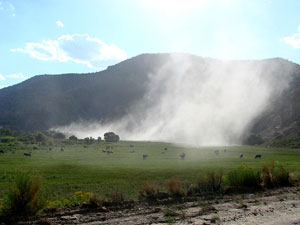Protecting Nine-Mile Canyon
“If there is any good to be achieved over the signing of an agreement affecting the archaeological remnants of the ancient peoples in Nine Mile Canyon, it is learning that people have to stand up and voice their opinions and special knowledge on matters that make a difference.
“A whole generation of citizens are growing up and must take it upon themselves to protect the history of humankind. They must study, vote and take action on subjects that matter to them, said Dr. Pam Miller.

This archived article was written by: press release
“If there is any good to be achieved over the signing of an agreement affecting the archaeological remnants of the ancient peoples in Nine Mile Canyon, it is learning that people have to stand up and voice their opinions and special knowledge on matters that make a difference.
“A whole generation of citizens are growing up and must take it upon themselves to protect the history of humankind. They must study, vote and take action on subjects that matter to them, said Dr. Pam Miller.
Citizens must protect our public lands. It must become easier for the public to be involved in this process. It sounds sweet to say the public lands are providing jobs and mineral beneficiaries. What will we have to show when all the natural gas or other nonrenewable resources are gone from the area?
Public lands are held in trust for the people of the United States and people have to take an interest in projects that impact these lands. People have to find out what the projects are and how they will affect other resources.
We have to ask ourselves who is checking up on the process and who must listen to our concerns. This is important to students because they are tomorrow’s leaders.
The College of Eastern Utah anthropology instructor was at the state capitol last week to sign an agreement between federal, state, Carbon and Duchesne counties, preservation, environmental and tribal groups; plus representatives from the Bill Barrett Corporation.
Utah Gov. Gary Herbert oversaw the signing of a pact that describes how the U.S. Bureau of Land Management and Bill Barrett Corporation will protect archaeological remains of the ancient people in Nine-Mile Canyon.
The creation of the document came about after many disputes with the Bill Barrett Corporation who expanded gas drilling in the area during the recent decade. The canyon is adjacent to land rich with energy resources.
The plan puts into motion many protections in the canyon that the Barrett Corporation must adhere to as the company drills for natural gas.
Although no drilling is allowed in the canyon, dust and vibrations from heavy equipment operating on the plateau and around the canyon are feared to damage the rock art and carvings. It is estimated that Nine-Mile Canyon has over 10,000 rock art drawings. The vehicles traveling through the canyon have created a coating of dust on the rock panels throughout the years.
According to an article in the Deseret News, “Under the agreement, Barrett must embrace an aggressive dust-suppression plan and require its 35 employees in that area, as well as subcontractors, to be schooled in mitigating any impacts to cultural resources as a result of their activities.
“Additionally, the corporation will fund a cultural resource inventory of the area and participate in the creation of a visitor interpretation site featuring walking paths and information kiosks.”
Preservations want to protect the cultural resources of the canyon and preserve them for future generations. Bill Barrett responded by adding dust suppressants in the past, but groups felt that they have disintegrated and added to the problem. However Barrett’s company has tested new suppressants and reportedly seen positive results.
The agreement testifies that groups and agencies with different and sometimes competing interests can meet together, share information and concerns, and come to an agreement that will hopefully work out best for Nine-Mile Canyon and its unique resources.
Nine-Mile Canyon is nearly 40 miles of the most spectacular rock art in Utah located northeast of Price on U.S. 6 approximately five miles from Price. It is remote, hostile and roughly beautiful.
Called “the world’s longest art gallery,” it is home to numerous rock art panels, including the famous “Hunter Panel.” Most of the rock art was created by the Fremont Indians who occupied this area some 1,000 years ago. People come to the Price area from all over the world to view the rock art.




